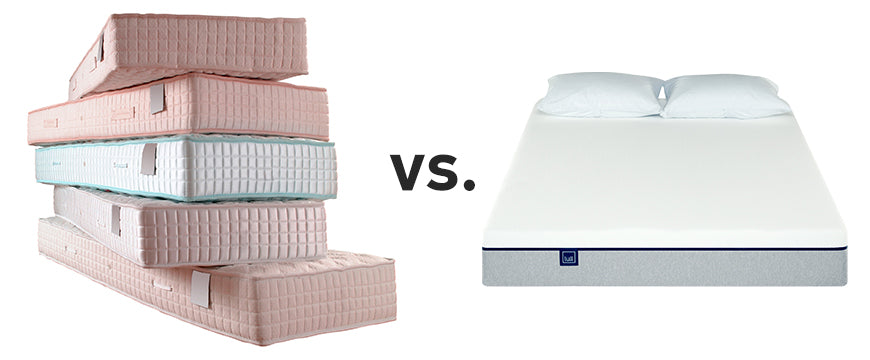
Mattress Matchup: Traditional vs. Foam
Share
When deciding on a new mattress, knowing the facts about 2 of the mainly available mattress types is essential in helping you to choose the right mattress and get that amazing night’s sleep that you’ve been dreaming about. In the world of mattress comparison, there are two heavy hitters: the traditional innerspring mattress and the newer memory foam mattress.
When picking a fighter in the ongoing mattress shopping battle, should you stick with the old-school choice and go with a pillow-top innerspring mattress or make the leap to the world of memory foam? This comparison of the two competitors might help you to make the right choice for you.
In the Traditional Corner…
The innerspring mattress first appeared on the market in the beginning of the 20th century and was made up of a core of steel coil springs, a layer of “cushioning materials,” and a quilted cover.
While innerspring mattresses do have a certain appeal due to their typically lower cost, built-in ventilation source from multiple springs, and the lack of wait time for the mattress to “conform” to your body (as a memory foam mattress does), they are lacking in some pretty important areas.
Innerspring mattresses have no real give to them, due to the fact that they are composed of steel springs. This causes an uneven distribution of weight, which in turn causes undue pressure on the spine and joints. The springs also tend to push the pressure points of the body, causing tossing and turning, as well as back pain. All of that moving around during sleep can also cause the springs to loosen, which creates lumps in the mattress surface, further disrupting sleep.
Traditional mattresses also have a higher level of upkeep, as they have to be rotated and sometimes even flipped in an effort to prevent the eventual breakdown of the springs, and need to be replaced more often due to the typical wear and tear of upholstered covers and the springs themselves.
In the Newcomer Corner…
Memory foam was first introduced to the world in the 1980s as a byproduct of NASA innovation, and the first popular consumer version of a foam mattress hit the market in the 1990s.
These mattresses were made to conform to the body, which enables weight to be distributed evenly and prevents the irritation of pressure points, misalignment of the spine, and a decrease in tossing and turning. All of this leads to a deeper, undisturbed sleep.
Weight isn’t the only thing that is distributed evenly in memory foam mattresses. Motion is also much less noticeable, which is very helpful when sharing the bed with a partner, allowing the act of getting in and out of bed to go virtually unnoticed by the other party.
Memory foam mattresses offer a much more comfortable sleeping experience due to the fact that they hit the mattress “sweet spot” by being not too soft and not too firm, and due to being made of highly durable materials, foam mattresses also tend to last much longer than traditional innerspring mattresses and they require zero maintenance.
And the winner is...
After watching these two mattress types duke it out in the categories of comfort and durability, the clear winner of the matchup is the memory foam newcomer. For those that are interested in the best night’s sleep possible, a memory foam mattress is definitely the way to go.
